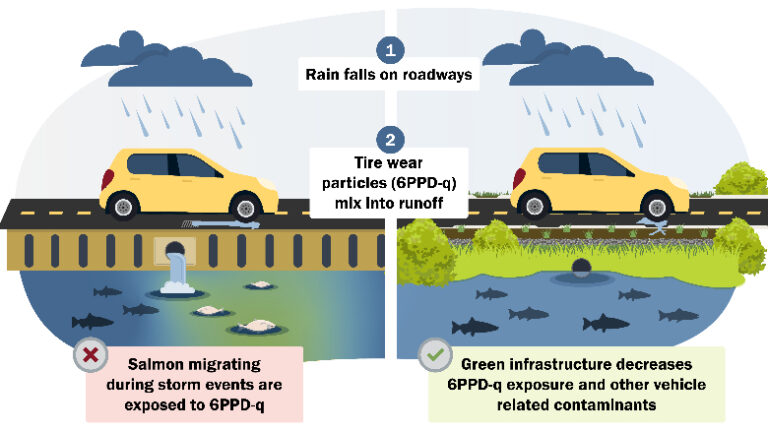Action triggered by petition concerning indirect impact on salmon habitats
EPA officials say a chemical used in tire production reacts with ozone pollution and can kill aquatic species when stormwater runoff washes it into waterways. Graphic courtesy of State of Washington Dept. of Ecology
November 3, 2023
The U.S. Environmental Protection Agency on Nov. 2 granted a petition by environmental advocates and three tribes to address the chemical 6PPD used in tire production because of the possible negative impact on salmon habitats through pavement stormwater runoff. The decision sets the stage for the agency to take steps to better understand potential risks associated with the chemical, especially regarding groundwater pollution and even regarding humans, as well as the need for regulation.
The chemical is widely used in tire and other rubber product manufacturing. When tire particles wear off during use, 6PPD reacts with ozone in the air to form 6PPD-quinone, which then is washed into waterways as stormwater runoff from streets and parking lots, exposing aquatic organisms to the chemical.
That’s a problem, according to environmental nonprofit Earthjustice, which submitted the petition in August on behalf of the Yurok Tribe, Port Gamble S’Kallam Tribe and Puyallup Tribe of Indians. The group says 6PPD-quinone is “the second most toxic chemical to aquatic species ever evaluated.”
The petition asks EPA to prohibit the use of 6PPD in tires, used to prevent degradation and cracking of rubber compounds, according to the U.S. Tire Manufacturers Association. The reaction that results in 6PPD-quinone was discovered in 2020.
In a statement, the Puyallup Tribal Council said a ban would be “hugely important” to protect coho salmon and other fish. “6PPD is a major and uniquely lethal threat to the health of salmon in urban streams on our reservation,” the council said.
In its letter granting the petition, EPA did not promise an outright ban but said it would publish by next fall an advanced notice of proposed rulemaking under the Toxic Substances Control Act (TSCA). The law grants the agency authority to develop regulations to restrict production or disposal of chemicals deemed to cause risk to human health or the environment.
The chemical can kill coho salmon within hours, and is responsible for the urban runoff mortality syndrome, which kills the fish as they return to urban streams to spawn, according to Earthjustice.
EPA also plans to gather more information that could inform its rulemaking. The petition highlights studies which found the presence of 6PPD-quinone in soil, household dust and the urine of pregnant women. Officials noted that while research has already shown 6PPD-quinone is toxic to […]
Full article: www.enr.com

